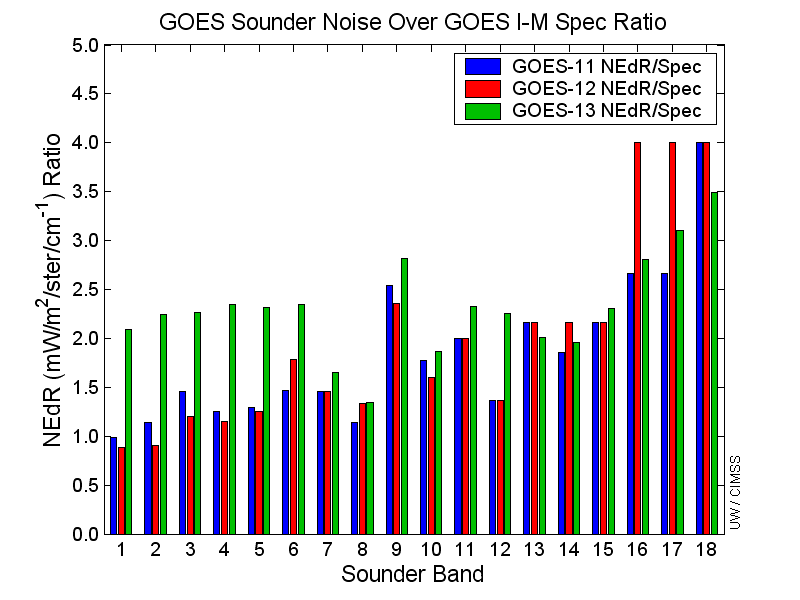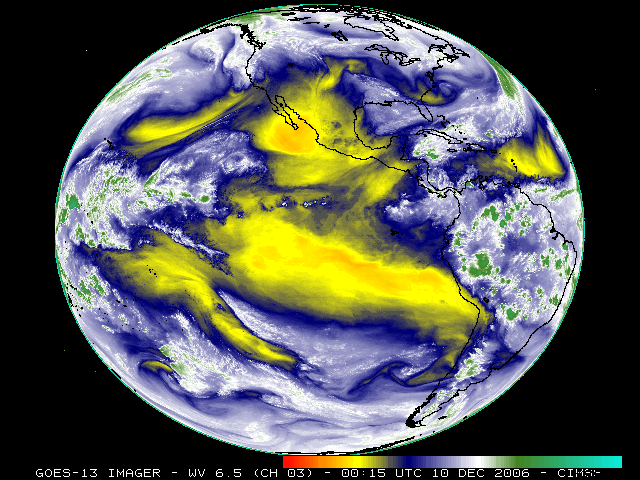 |
CIMSS-NOAA Weekly Report
[ Archive ] |
 |
ASPB AND CIMSS WEEKLY HIGHLIGHTS FOR THE WEEK ENDING DECEMBER 15, 2006
IN
THE PRESS:
ITEMS
FOR THE ADMINISTRATOR:
ITEMS FOR THE ASSISTANT ADMINISTRATOR
ITEMS FOR THE OFFICE DIRECTOR, STAR
Presentation on GOES Sounder Applications at Chinese Academy of Meteorological Science:
Jun Li was invited to visit Institute of Atmospheric Physics (IAP) and
Chinese Academy of Meteorological Science (CAMS) December 4-8, 2006.
He collaborated with scientists at IAP on applying AIRS/MODIS
cloud-clearing soundings developed at CIMSS in a regional forecast
model. He also gave a talk on December 8 at CAMS entitled
"Applications of GOES Sounder data on severe weather forecasts". Jun
Li's travel was supported by IAP. (Jun Li, CIMSS, 608 - 262 -3755,
Jun.Li@ssec.wisc.edu)
ITEMS FOR THE DIVISION CHIEF, CoRP
Redesign of CIMSS GOES Derived Product Imagery Web Page:
Although numerous additions and enhancements had been added to the
CIMSS (Cooperative Institute for Meteorological Satellite Studies)
Realtime GOES (Geostationary Operational Environmental Satellite) Page
over the last ten years, the overall page architecture had not changed
since its inception, until now. The redesigned CIMSS GOES Realtime
Derived Product Imagery (DPI) Page has a fresh compact look,
flexibility to more easily compare user-selected DPI, and a coding
framework to permit much easier management of the page. See http://cimss.ssec.wisc.edu/goes/rt/. (B. Bellon, CIMSS, 608-263-6726; G.S. Wade, E/RA2, 608-263-4743; T.J. Schmit, E/RA2, 608-263-0291)
Preliminary Quantification of GOES-13 Sounder Noise:
Scientists at the Cooperative Institute for Meteorological Satellite
Studies (CIMSS) have preliminary noise numbers for the sounder using
special space-look data taken during the Geostationary Operational
Environmental Satellite (GOES)-13 science test. Overall, GOES-13
sounder noise appears to be well within the specifications for GOES
8-12 and either better than, or comparable to, those of the current
operational sounders on GOES-11 and GOES-12. Hourly space-look
data provided a day-long sampling of such standard deviations and the
average over the day was used for GOES-13. (M. Gunshor, CIMSS,
608-263-1146; T. Schmit, E/RA2,
608-263-0291, tim.j.schmit@noaa.gov).
 (Click image to enlarge)
(Click image to enlarge)
Caption: The ratio of GOES sounder noise calculations (from space-looks) to the GOES I-M specification for noise.
Second Week of GOES-13 Science Test - Many Unique Observations:
Several unique schedules were run during the second week of the
Geostationary Operational Environmental Satellite (GOES)-13 NOAA
Science Test. These include full disk images every 30 minutes, the
longest duration ever of 30-second imager data, hot spots due to fires
and space-views with the sounder for noise determinations and
enumlating the GOES-East and -West schedules. More information
can be found at http://cimss.ssec.wisc.edu/goes/blog/category/goes-13/ or http://rammb.cira.colostate.edu/projects/goes_n/.
(T. Schmit, E/RA2, 608-263-0291, tim.j.schmit@noaa.gov, S. Bachmeier,
CIMSS, 608-263-3958, G.S. Wade, E/RA2, 608-263-4743,
gary.s.wade@noaa.gov).
 (Click image to enlarge animation)
(Click image to enlarge animation)
Caption: This GOES-13 Imager "water vapor" band animation shows full
disk images every 30 minutes. Due to the need for regional and
meso-scale scanning, the operational GOES Imagers routinely scan the
full disk only every 3 hours.
Second Meeting of NOAA International Affairs Council Polar Committee:
The Polar Committee of the NOAA International Affairs Council (IAC)
held its second meeting on December 15. The committee was established
to serve as a policy coordinating forum, to maintain awareness of
NOAA’s work in the polar regions and, as appropriate, to address
crosscutting program issues. Jeff Key is the NESDIS representative on
the Polar Committee. He participated by phone. Topics discussed at the
meeting included the National Science Foundation congressional
testimony on the International Polar Year (with NOAA input), Antarctic
policy discussions with the State Department, impacts of the continung
resolution on polar acitivities, and recent meetings of the Arctic
Council. (J. Key, E/RA2, 608-263-2605, jeff.key@noaa.gov)
Other Meetings and Telecons:
None.
VISITORS:
NEXT WEEK:
LOOKING AHEAD:
Archived Weeklies Page




 (Click image to enlarge)
(Click image to enlarge) (Click image to enlarge animation)
(Click image to enlarge animation)